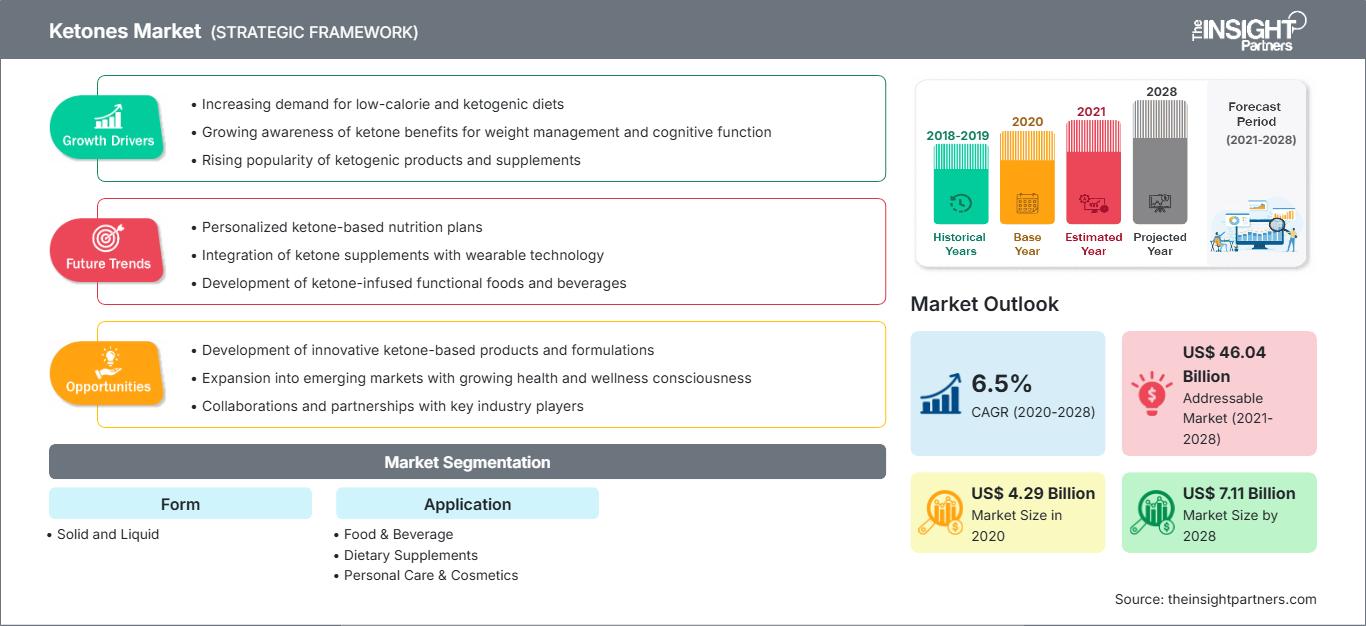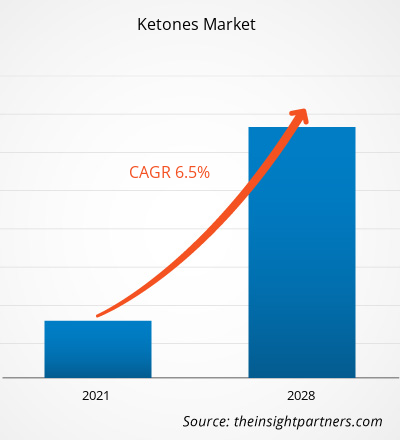[Forschungsbericht]Der Ketonmarkt wurde im Jahr 2020 auf 4.286,5 Millionen US-Dollar geschätzt und soll bis 2028 7.106,5 Millionen US-Dollar erreichen; von 2021 bis 2028 wird ein CAGR-Wachstum von 6,5 % erwartet.
Ketone wie Aceton, Methylethylketon und Diisobutylketone werden häufig als industrielle Lösungsmittel und chemische Zwischenprodukte zur Herstellung von Beschichtungen, Klebstoffen, Farben, Farbentfernern, Gummi, Kunststoffen und pharmazeutischen Produkten verwendet. Darüber hinaus werden exogene Ketone in Nahrungsergänzungsmitteln verwendet. Sie bestehen üblicherweise aus Ketonsalzen, auch bekannt als Beta-Hydroxybutyrat oder BHB, und Ketonestern.
Im Jahr 2020 hatte der asiatisch-pazifische Raum den größten Anteil am globalen Ketonmarkt und wird im Prognosezeitraum voraussichtlich die höchste CAGR des Marktes verzeichnen. Die steigende Nachfrage nach gesundheitsfördernden Nahrungsergänzungsmitteln ist einer der Hauptfaktoren für das Marktwachstum im asiatisch-pazifischen Raum. Veränderte Essgewohnheiten aufgrund des hektischen Lebensstils und gesundheitlicher Bedenken fördern ebenfalls das Wachstum des Ketonpräparatmarktes in der Region. Laut dem Internationalen Institut für Nachhaltige Entwicklung trägt die Chemiebranche im asiatisch-pazifischen Raum über 45 % zur weltweiten Chemieproduktion bei und stellt mehr als 69 % der globalen Arbeitsplätze in der Chemiebranche. In der chemischen Industrie werden Ketone häufig als Lösungsmittel und Katalysatoren eingesetzt. Daher wird erwartet, dass die etablierte Chemieindustrie im asiatisch-pazifischen Raum das Wachstum des Ketonmarktes in der kommenden Zeit ankurbeln wird.
Passen Sie diesen Bericht Ihren Anforderungen an
Sie erhalten kostenlos Anpassungen an jedem Bericht, einschließlich Teilen dieses Berichts oder einer Analyse auf Länderebene, eines Excel-Datenpakets sowie tolle Angebote und Rabatte für Start-ups und Universitäten.
Ketone-Markt: Strategische Einblicke

-
Holen Sie sich die wichtigsten Markttrends aus diesem Bericht.Dieses KOSTENLOSE Beispiel umfasst Datenanalysen, die von Markttrends bis hin zu Schätzungen und Prognosen reichen.
Auswirkungen der COVID-19-Pandemie auf den Ketonmarkt
Die COVID-19-Pandemie hat aufgrund vieler Faktoren wie verlängerten Lockdowns in verschiedenen Regionen, Beschränkungen des internationalen Handels, Schließung von Produktionseinheiten, Reiseverboten, Zerfall der Lieferkette und Rohstoffknappheit drastische Auswirkungen auf Umsatz und Betrieb verschiedener Branchen. Die Lebensmittel- und Getränkeindustrie sowie die chemische Industrie gehören zu den bedeutenden Sektoren, die aufgrund des COVID-19-Ausbruchs unter schweren Störungen wie Lieferkettenbeschränkungen und Schließung von Produktionsanlagen litten. Die Schließung verschiedener Anlagen und Fabriken in führenden Regionen wie Nordamerika, Europa und Asien-Pazifik hat die globale Lieferkette, Fertigungsaktivitäten, Lieferpläne und den Verkauf verschiedener Produkte behindert. All diese Faktoren wirkten sich negativ auf die Chemie- sowie die Lebensmittel- und Getränkeindustrie aus. Ketone werden in der chemischen Industrie häufig als Lösungsmittel, chemische Zwischenprodukte und als Katalysatoren verwendet. Sie sind auch in der Farben- und Lackindustrie sehr gefragt. Beschichtungen, Klebstoffe, Druckfarben und ähnliche Branchen. Sie werden auch in der Galvanotechnik als Kaltreinigungslösungsmittel, Dampfentfettungsmittel und Laborchemikalien eingesetzt. Ketone werden auch bei der Herstellung von Nahrungsergänzungsmitteln, Proteinshakes und -pulvern sowie Arzneimitteln verwendet. Störungen bei der Rohstoffbeschaffung von Lieferanten und vorübergehende Schließungen von Produktionsstandorten aufgrund unbefristeter Lockdowns und vorübergehender Quarantänen haben das Marktwachstum während der Pandemie gebremst. Die Pandemie hat jedoch bei den Verbrauchern das Bedürfnis nach einer gesunden Lebensweise geweckt. Daher haben die Verbraucher ihre Aufmerksamkeit auf ihre persönliche Gesundheit und eine nahrhafte Ernährung verlagert. Daher stieg die Nachfrage nach Produkten zur Gewichtskontrolle und Ketonpräparaten während der Pandemie sprunghaft an, was den Ketonmarkt direkt ankurbelte. Im ersten Quartal 2020 waren die Umsätze schleppend, da viele Geschäfte geschlossen waren. Die Unternehmen holen jedoch wieder auf, da zuvor verhängte Beschränkungen vielerorts gelockert werden. Darüber hinaus hat die Einführung von COVID-19-Impfstoffen durch Regierungen verschiedener Länder die Situation weiter entspannt, was zu einem Anstieg der Geschäftstätigkeit weltweit geführt hat. Die Lebensmittel- und Getränkeindustrie gleicht ihre Verluste aus, indem sie ihre Produktionseinheiten öffnet und den Betrieb mit der Hälfte der Kapazitäten wieder aufnimmt. Diese Faktoren dürften das Marktwachstum im Prognosezeitraum vorantreiben.
Markteinblicke
Steigende Nachfrage aus verschiedenen Branchen
Ketone sind vielseitige organische Verbindungen mit vielfältigen Anwendungen in verschiedenen Branchen. Aceton, Methylethylketon, Methylisobutylketon und Diisobutylketon gehören zu den wichtigen Ketonen, die üblicherweise bei der Herstellung von Harzen, Kunststoffen, Farben und Lacken, Lasuren, Beschichtungen, Gummiprodukten und anderen Industrieprodukten verwendet werden. Aceton wird in Nagellackentfernern verwendet. In der Textilindustrie wird es häufig zum Entfetten von Wolle und zum Entbasten von Seide eingesetzt. Aceton wird häufig als Lösungsmittel bei der Herstellung von Lacken für die Auto- und Möbelindustrie verwendet. Es kann auch zur Verringerung der Viskosität von Lacklösungen eingesetzt werden. Die Farben- und Lackindustrie deckt mehr als die Hälfte der Nachfrage nach Methylethylketon (MEK)-Produkten ab, da sich mit diesen Materialien niedrigviskose Lösungen herstellen lassen, ohne dass die Filmeigenschaften beeinträchtigt werden. Diese Lacke werden in der Automobil-, Elektrogeräte- und Möbelindustrie eingesetzt. Lacke eignen sich hervorragend als Lösungsmittel für Oberflächenbeschichtungen und sind unverzichtbar für die Herstellung von High-Solid-Beschichtungen mit geringen Emissionen. MEKs werden auch bei der Herstellung von Polymeren und Textilien sowie von Druckfarben, Klebstoffen, Insektiziden und gummibasierten Industriezementen verwendet. Ketone finden breite Anwendung in der Lebensmittel- und Getränkeindustrie sowie in der Pharma- und Nutraceuticals-Industrie, wo sie unter anderem zur Herstellung von Nahrungsergänzungsmitteln, Energydrinks, trinkfertigen Shakes und Shake-Pulvern verwendet werden. Ketonbasierte Lebensmittel und Nahrungsergänzungsmittel unterstützen die Gewichtsabnahme, da sie die Nutzung von im Körper abgelagerten Fetten anregen. Darüber hinaus wird erwartet, dass die wachsende Beliebtheit von Ketonen als Fraktionierungsmittel bei der Extraktion von Ölen und Fetten sowie die steigende Nachfrage nach diesen Verbindungen zur Sterilisation medizinischer Geräte aufgrund ihrer keimtötenden Wirkung das Marktwachstum im Prognosezeitraum weiter vorantreiben werden. Ketone werden aufgrund ihres angenehmen Geruchs auch bei der Herstellung von Körperpflege- und Kosmetikprodukten verwendet. Darüber hinaus dienen sie als chemische Zwischenprodukte in verschiedenen pharmazeutischen und chemischen Produktionsanlagen. Daher trägt die kontinuierlich steigende Nachfrage nach Ketonen aus verschiedenen Branchen, wie der Automobilindustrie, der Farben- und Lackindustrie, der Klebstoff- und Harzherstellung, der Lebensmittel- und Getränkeindustrie, der Pharma- und Nutrazeutikaindustrie sowie der Körperpflege- und Kosmetikindustrie, zum Wachstum des Ketonmarktes bei.
Form Insights
Basierend auf der Form ist der Ketonmarkt in fest und flüssig unterteilt. Das Flüssigsegment hatte 2020 einen größeren Marktanteil und das Feststoffsegment dürfte im Prognosezeitraum eine höhere durchschnittliche jährliche Wachstumsrate (CAGR) verzeichnen. Flüssige Ketone werden als Lösungsmittel und Katalysatoren unter anderem bei der Herstellung von Beschichtungen, Klebstoffen, Druckfarben, chemischen Zwischenprodukten, Parfüms, Lacken, Farbentfernern, Schmiermitteln sowie Kunststoffen und Harzen verwendet. Aceton, Diisobutylketon, Methylethylketon, Methylisobutylenketon usw. sind die am häufigsten auf dem Markt erhältlichen flüssigen Ketone. Flüssige Ketone sind für ihren unverwechselbaren, angenehmen Geruch bekannt. Ketonester werden in flüssiger Form in Nahrungsergänzungsmitteln verwendet. Die steigende Nachfrage nach flüssigen Ketonen von Chemieunternehmen trägt maßgeblich zum Wachstum des Marktes für flüssige Produkte bei.
Anwendungseinblicke
Basierend auf der Anwendung ist der Ketonmarkt in Lebensmittel und Getränke, Nahrungsergänzungsmittel, Körperpflege und Kosmetik usw. unterteilt. Das sonstige Anwendungssegment hatte 2020 den größten Marktanteil, und das Segment Nahrungsergänzungsmittel dürfte im Prognosezeitraum die höchste durchschnittliche jährliche Wachstumsrate (CAGR) auf dem Markt verzeichnen. Ketone finden außerdem in der Chemie und Industrie Anwendung. Ketone wie Methylethylketon, Methylisobutylketon, Diisobutylketon und Aceton sind in der Chemieindustrie weit verbreitete chemische Zwischenprodukte. Aceton wird häufig als chemisches Zwischenprodukt bei der Herstellung von Acrylkunststoffen, Polycarbonaten und Epoxidharzen verwendet. Diisobutylketon wird außerdem als chemisches Zwischenprodukt bei der Synthese von Diisobutylcarbinol eingesetzt. Methylethylketone werden ebenfalls als chemisches Zwischenprodukt bei der Herstellung bestimmter pharmazeutischer Produkte verwendet. Acrylkunststoffe und Epoxidharze werden häufig in der Automobil- und Beschilderungsindustrie eingesetzt. Diisobutylcarbinol wird bei der Synthese von Wasserstoffperoxid, Lacken, Schellack, Druckfarben, Vinylchloridacetatharzen, Harnstoffmelaminharzen und Alkydharzen verwendet. Ketone werden als industrielle Lösungsmittel bei der Herstellung von Farben und Beschichtungen, Klebstoffen, Autolacken, Gummi, Textilien, Lacken, Druckfarben usw. verwendet. In der Beschichtungsindustrie werden sie häufig als Lösungsmittel bei der Produktion von Nitrocellulose und anderen Celluloseestern, Harzen und Vinylchlorid-Vinylacetat eingesetzt. Diese Lösungsmittel können als aktive Lösungsmittel oder Verdünnungsmittel verwendet werden und werden oft in Verbindung mit anderen Lösungsmitteln eingesetzt. Methylethylketone werden häufig als Lösungsmittel bei der Gummiherstellung verwendet. Darüber hinaus werden Ketone als Fraktionierungsmittel bei der Extraktion von Ölen und Fetten eingesetzt. Sie werden verwendet, um medizinische Geräte wie chirurgische Instrumente, Injektionsnadeln, Spritzen und zahnärztliche Instrumente zu sterilisieren.
Einige Akteure auf dem Ketonmarkt sind Compound Solutions Inc.; Aurochemicals; Taj Pharmaceuticals Chemicals; Orchid Chemical Supplies Ltd; Hunan NutraMax Inc.; HEALTH SOURCES NUTRITION CO., LTD.; Advanced Biotech; Eastman Chemical Company; Royal Dutch Shell plc.; und SABIC.
Ketonmarkt
Die Analysten von The Insight Partners haben die regionalen Trends und Faktoren, die den Ketonmarkt im Prognosezeitraum beeinflussen, ausführlich erläutert. In diesem Abschnitt werden auch die Ketonmarktsegmente und die geografische Lage in Nordamerika, Europa, dem asiatisch-pazifischen Raum, dem Nahen Osten und Afrika sowie Süd- und Mittelamerika erörtert.Umfang des Ketonmarktberichts
| Berichtsattribut | Einzelheiten |
|---|---|
| Marktgröße in 2020 | US$ 4.29 Billion |
| Marktgröße nach 2028 | US$ 7.11 Billion |
| Globale CAGR (2020 - 2028) | 6.5% |
| Historische Daten | 2018-2019 |
| Prognosezeitraum | 2021-2028 |
| Abgedeckte Segmente |
By Form
|
| Abgedeckte Regionen und Länder |
Nordamerika
|
| Marktführer und wichtige Unternehmensprofile |
|
Dichte der Marktteilnehmer für Ketone: Verständnis ihrer Auswirkungen auf die Geschäftsdynamik
Der Ketonmarkt wächst rasant, angetrieben durch die steigende Endverbrauchernachfrage aufgrund von Faktoren wie sich entwickelnden Verbraucherpräferenzen, technologischem Fortschritt und einem größeren Bewusstsein für die Produktvorteile. Mit steigender Nachfrage erweitern Unternehmen ihr Angebot, entwickeln Innovationen, um den Verbraucherbedürfnissen gerecht zu werden, und nutzen neue Trends, was das Marktwachstum weiter ankurbelt.

- Holen Sie sich die Ketone-Markt Übersicht der wichtigsten Akteure
Bericht-Spotlights
- Fortschreitende Branchentrends im Ketonmarkt, die den Akteuren bei der Entwicklung effektiver langfristiger Strategien helfen
- Geschäftswachstumsstrategien in entwickelten und sich entwickelnden Märkten
- Quantitative Analyse des Ketonmarkts von 2019 bis 2028
- Schätzung der weltweiten Nachfrage nach Ketonen
- Porters Fünf-Kräfte-Analyse zur Veranschaulichung der Wirksamkeit von Käufern und Lieferanten in der Branche
- Jüngste Entwicklungen zum Verständnis des wettbewerbsorientierten Marktszenarios
- Markttrends und -aussichten sowie Faktoren, die das Wachstum des Ketonmarkts vorantreiben und hemmen
- Unterstützung im Entscheidungsprozess durch Hervorhebung von Marktstrategien, die das kommerzielle Interesse untermauern und zum Marktwachstum führen
- Die Größe des Ketonmarkts an verschiedenen Knotenpunkten
- Detaillierte Übersicht und Segmentierung des Marktes sowie der Ketonbranche Dynamik
- Größe des Ketonmarktes in verschiedenen Regionen mit vielversprechenden Wachstumschancen
Ketonmarkt – nach Form
- Fest
- Flüssig
Ketonmarkt – nach Anwendung
- Lebensmittel und Getränke
- Nahrungsergänzungsmittel
- Körperpflege und Kosmetik
- Sonstige
Firmenprofile
- Compound Solutions Inc.
- Aurochemicals
- Taj Pharmaceuticals Chemicals
- Orchid Chemical Supplies Ltd
- Hunan NutraMax Inc.
- HEALTH SOURCES NUTRITION CO., LTD.
- Advanced Biotech
- Eastman Chemical Company
- Royal Dutch Shell plc.
- SABIC
- Historische Analyse (2 Jahre), Basisjahr, Prognose (7 Jahre) mit CAGR
- PEST- und SWOT-Analyse
- Marktgröße Wert/Volumen – Global, Regional, Land
- Branchen- und Wettbewerbslandschaft
- Excel-Datensatz
Aktuelle Berichte
Erfahrungsberichte
Grund zum Kauf
- Fundierte Entscheidungsfindung
- Marktdynamik verstehen
- Wettbewerbsanalyse
- Kundeneinblicke
- Marktprognosen
- Risikominimierung
- Strategische Planung
- Investitionsbegründung
- Identifizierung neuer Märkte
- Verbesserung von Marketingstrategien
- Steigerung der Betriebseffizienz
- Anpassung an regulatorische Trends






















 Kostenlose Probe anfordern für - Ketone-Markt
Kostenlose Probe anfordern für - Ketone-Markt